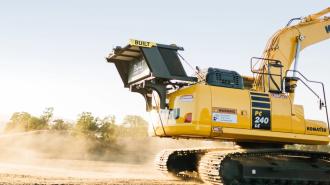Since the Neolithic Era, humanity has been slowly perfecting the art and science of construction. While some of history’s greatest construction feats were built by hand, the relatively recent introduction of mechanized tools has drastically improved the building process.
It’s only been about two centuries since builders moved beyond hand tools to machinery like water-powered hydraulic cranes and steam rollers. But like many innovations stemming from the Industrial Revolution, these inventions merely amplified human muscles and were still big, dumb machines that required people to be constantly at the wheel.
As our technology gets smarter and computers become increasingly better at replicating human behavior, new machines that can do more than mimic human muscles are slowly becoming more common on job sites. Of course, humans are still part of the construction process — people like Clayton Maute, who recently became the second person in the United States to be certified as a Robotic Equipment Operator (REO) for construction jobs.
Watch the full video on Built Robotics:
A self-driving excavator
Maute has recently worked with an autonomous excavator designed by Built Robotics, a California-based startup that designs autonomous construction equipment. The company’s “Exosystem” technology attaches to a regular excavator and converts it into a mostly autonomous robot.
Why design an automatic excavator? Excavation is a necessary step in virtually every construction project because it creates a strong foundation on top of which workers can build structures. Although relatively straightforward, this process takes time, can be dangerous, and sometimes causes costly delays if mistakes are made.
The autonomous excavator aims to reduce those setbacks. Once turned on, the unit can be given a digging task to complete inside a digital “geofence” that it can’t wander past or swing its giant arm outside of.
The robotic excavator can also dig ditches in straighter lines than human operators. By using a laptop, the person supervising the machine can determine where the trench will go, where the robot will place the dirt (often in piles called “spoils”), and all the other desired parameters. The software will even provide an estimated time to completion.
“It does dig a very straight trench,” Maute said. “It digs it to the depth that you want it to, and it digs for as long as you want it to. So, it really speeds up the day for us.”
The process isn’t entirely autonomous, however. The geofence has to be physically drawn by a human, the work has to be supervised, and the robot can’t make any major decisions, like where the best place is to dig the trench. Additionally, it can only dig trenches in straight lines. While these lines are better than the ones you can expect from a typical human operator across many metrics, it can’t build an entire apartment building alone; a machine that can replicate every part of construction work doesn’t exist yet.
“The robot just digs,” Maute said. “So, I have to do everything for the robot to dig.”
Of course, like the best “dumb” labor-saving technologies, this still allows Clayton to focus on tasks that robots can’t handle, or even just to prepare for the next task. Something this simple can be a boon to productivity, even if it doesn’t exactly resemble how science fiction has depicted the future of humans working with robots.
In AI, the degree of intelligence a particular machine can demonstrate is measured on a wide spectrum. Toward the most intelligent end of that spectrum lies a concept called general artificial intelligence (AGI), which describes machines that can replicate most of the cognitive abilities of a human being (science fiction is chock full of examples).
The Exosystem falls into the category of “weak AI.” Programs like this can only do one straightforward task, though they often do that task extremely well. Whether AGI is possible, and whether we are going to invent it anytime soon, is still a matter of debate. For now, we have a robot that can dig trenches better than any human being. This is nothing to laugh at, though — even this can be a literal lifesaver.
The benefits of a giant digging robot
Construction workers endure the third-highest injury rate in any industry in the United States. In 2020, 1,008 American construction workers died on the job, accounting for 20% of all worker deaths in the country, despite the industry only employing 6% of workers.
While it probably goes without saying, the fact that nobody is inside or even near the 80,000-pound machine makes working with it a lot safer. By removing the human element from this task, the possibility of injury declines. Not only will robots at the construction site complete work at a higher standard than humans (who will be free to do other work), but it will also allow some people to be able to go home rather than to the hospital, or the morgue.
“There’s no one in the machine to get hurt,” Maute said. “There’s no one that needs to be around the machine to get hurt. So, you’ve taken all the danger right out of it. I think the future of construction definitely is looking towards more autonomous machines. [If] you can eliminate any sort of accidents, a lot of companies, I think, are going to go towards the autonomous way.”
In addition to enjoying safer working conditions, REO-certified construction workers — who must complete a 30-hour REO training program in conjunction with their union — can often look forward to pay increases and other benefits that come with a more productive, safer worksite.
Maute noted that it can be a rather fun and exciting tool to work with:
“I’m really excited about it, not only because I have done the REO program and I’ve seen what it can be. We’re in the premature stage of these autonomous machines, especially out at construction sites. I like it that I’m here at the beginning and not when it’s the cool thing to do.”
Even though your next house probably won’t have a robotic maid that can do everything for you, it might be built with a robot that performs simple tasks very well. All things considered, it’s still a pretty cool future to live in — even if the first reaction most people have when seeing an excavator moving without anybody controlling it is to freak out a little.






